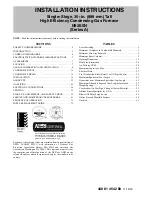
PLB-098
Oil Furnaces
–
Furnace Manual
11/13
5
1.5.
VENTING
Poisonous carbon monoxide gas, fire and
explosion hazard.
Read and follow all instructions in this section.
Failure to properly vent this furnace can result
in death, bodily injury and/or property damage.
To ensure the safe and proper functioning of an
oil furnace, it must always be connected to a
flue with sufficient draft or to an approved side-
wall venting system. In addition, it is strongly
recommended to perform a complete inspection
of all the existing venting systems.
Poisonous carbon monoxide gas hazard.
Never install a hand operated damper in the
vent pipe. However, any Underwriters
Laboratories listed, electrically operated
automatic type vent damper may be installed if
desired. Be sure to follow the instructions
provided with vent damper. Also, read and
follow all instructions in this section of the
manual.
Failure to properly vent this furnace or other
appliances can result in death, bodily injury
and/or property damage.
1.5.1.
Masonry chimney
This furnace can be vented into an existing masonry chimney.
However, the unit must not be vented into a chimney into which a
solid fuel burning furnace is already being vented.
Before venting this furnace into a chimney, its condition must be
checked and repairs made, if necessary. Also, the chimney lining
and dimensions must conform to local and national codes.
1.5.2.
Factory Built Chimneys
Oil fired furnaces are approved for use with “L” type vents. The
unit may also be used with an approved chimney of proper
dimensions and temperature ratings as specified in the
installation code. Refer to chimney manufacturer’s instructions for
proper installation.
1.5.3.
Draft Regulator
It is recommended that a draft regulator be installed in cases
where the draft is either high or variable due to external
conditions. Follow the instructions provided with the regulator.
1.5.4.
Side-wall Venting
The heating unit is approved for side-wall venting. This system is
comprised of a model VTK-54 side-wall venter and a 4” insulated
vent pipe, model IFV-410, IFV-420. Refer to the installation
instructions provided with the venting system.
1.6.
BLOCKED VENT SHUT-OFF DEVICE
(BVSO) FOR CHIMNEY VENTING -
OPTIONAL
It is imperative that this device be installed by a
qualified service technician.
A positive pressure venting system (Sealed
Combustion System or Direct Vent) must NOT
use the BVSO. Follow the instructions supplied
with the venting system.
This device is designed to detect the insufficient evacuation of
combustion gases in the event of a vent blockage. In such a case
the thermal switch will shut down the oil burner. The device will
then need to be re-armed MANUALLY.
Refer to the detailed instructions and wiring diagrams supplied
with the BVSO for the installation and wiring procedures. The
length of wires supplied with the unit is such that the safety
device must be installed between the flue outlet of the appliance
and the draft regulator, as indicated in the instructions.
It is also essential that the BVSO be maintained annually. For
more details refer to the instructions supplied with the device
itself, as well as Section 2 of this Manual.
1.6.1.
BVSO Performance Test
(If installed)
The purpose of the following test is to check that the electrical
outlet on the furnace, designated to the BVSO, is functional.
1.
Start up the burner;
2.
Disconnect one wire of the BVSO;
3.
The burner must shut-off immediately, while the blower
continues to run to the end of the cool-down cycle.
If the test is not in line with the above, call a QUALIFIED
SERVICE TECHNICIAN.
Figure 5: BVSO mounting installation: Upflow with
vertical exhaust (OPTIONAL)
Figure 6: BVSO mounting installation: Upflow with
horizontal exhaust (OPTIONAL)






































